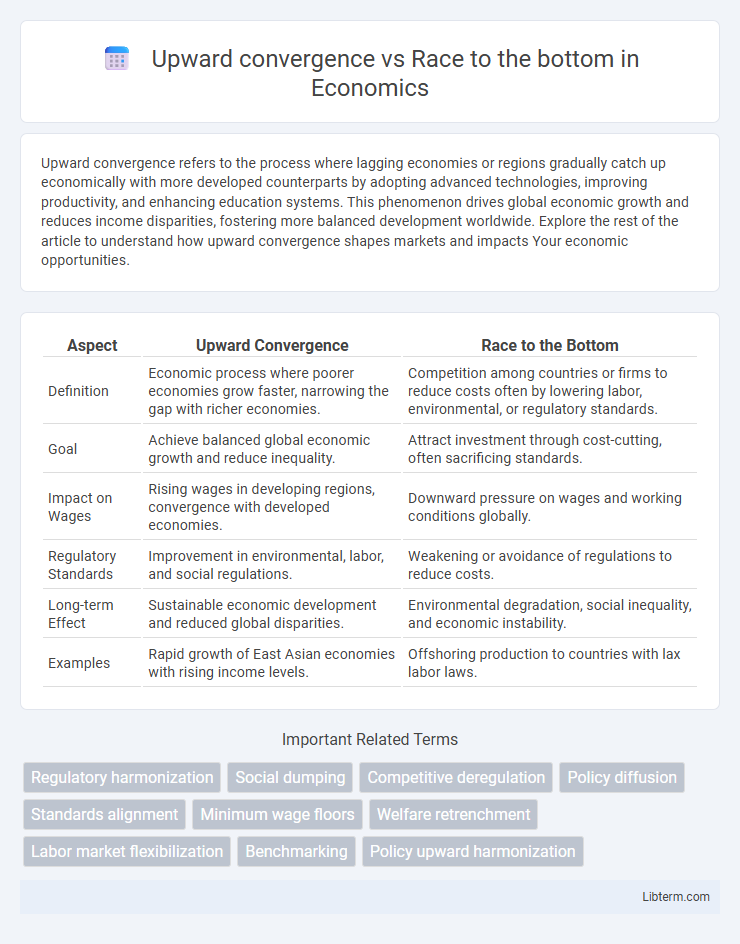Upward convergence refers to the process where lagging economies or regions gradually catch up economically with more developed counterparts by adopting advanced technologies, improving productivity, and enhancing education systems. This phenomenon drives global economic growth and reduces income disparities, fostering more balanced development worldwide. Explore the rest of the article to understand how upward convergence shapes markets and impacts Your economic opportunities.
Table of Comparison
| Aspect | Upward Convergence | Race to the Bottom |
|---|---|---|
| Definition | Economic process where poorer economies grow faster, narrowing the gap with richer economies. | Competition among countries or firms to reduce costs often by lowering labor, environmental, or regulatory standards. |
| Goal | Achieve balanced global economic growth and reduce inequality. | Attract investment through cost-cutting, often sacrificing standards. |
| Impact on Wages | Rising wages in developing regions, convergence with developed economies. | Downward pressure on wages and working conditions globally. |
| Regulatory Standards | Improvement in environmental, labor, and social regulations. | Weakening or avoidance of regulations to reduce costs. |
| Long-term Effect | Sustainable economic development and reduced global disparities. | Environmental degradation, social inequality, and economic instability. |
| Examples | Rapid growth of East Asian economies with rising income levels. | Offshoring production to countries with lax labor laws. |
Understanding Upward Convergence and the Race to the Bottom
Upward convergence refers to the process where countries or companies progressively adopt higher standards, such as improved labor laws or environmental regulations, aiming to match leading benchmarks and promote sustainable growth. The race to the bottom describes a competitive dynamic where entities deliberately lower standards, including wages or environmental protections, to attract business or investment, often resulting in negative socioeconomic and ecological consequences. Understanding both concepts highlights the tension between pursuing economic competitiveness through enhanced regulations versus sacrificing standards to reduce costs.
Origins and Historical Context
Upward convergence and race to the bottom emerged as contrasting theories in global economic development during the late 20th century, shaped by industrialization and globalization's effects on labor standards and regulatory policies. Upward convergence suggests that countries progressively adopt higher standards and regulations inspired by advanced economies, promoting improved social and environmental outcomes. The race to the bottom theory originates from concerns in the 1970s and 1980s about deregulation and competitive pressures leading countries to lower wages, environmental protections, and labor rights to attract foreign investment.
Key Drivers Behind Upward Convergence
Key drivers behind upward convergence include technological innovation, improved education systems, and robust institutional frameworks that foster economic growth and productivity gains. Increased foreign direct investment and enhanced infrastructure also play critical roles in enabling developing economies to catch up with advanced nations. Strong policy reforms targeting governance, innovation, and human capital development further accelerate the process of narrowing economic disparities.
Causes of the Race to the Bottom
The race to the bottom is primarily caused by globalization and competitive pressures that compel countries to lower labor costs, environmental standards, and corporate taxes to attract foreign investment. Multinational corporations exploit regulatory arbitrage, shifting operations to regions with weaker regulations to maximize profits. This downward pressure undermines social protections and environmental sustainability as governments prioritize economic growth over regulatory enforcement.
Economic Impacts of Both Phenomena
Upward convergence drives economic growth by promoting innovation, higher wages, and improved labor standards as countries or regions align with advanced economies, leading to enhanced productivity and investment flows. In contrast, the race to the bottom triggers economic pressures that erode labor rights, reduce environmental protections, and intensify tax competition, often resulting in decreased social welfare and income inequality. Both phenomena significantly influence global trade dynamics, foreign direct investment patterns, and long-term sustainable development outcomes.
Social and Environmental Consequences
Upward convergence fosters improved labor standards and environmental protections by encouraging countries to adopt higher regulatory benchmarks, reducing exploitation and ecological degradation. In contrast, the race to the bottom drives nations to lower wages, weaken labor rights, and relax environmental regulations to attract investment, resulting in increased social inequality and environmental harm. Sustainable development depends on policies promoting upward convergence to balance economic growth with social welfare and ecological preservation.
Policy Approaches: Regulation vs. Deregulation
Upward convergence in policy approaches emphasizes regulatory frameworks that raise standards across jurisdictions, promoting uniformity in labor, environmental, and safety regulations to enhance overall governance quality. Race to the bottom occurs when jurisdictions competitively lower regulations and standards to attract businesses, often resulting in reduced labor protections, environmental degradation, and weaker enforcement mechanisms. Policymakers must balance regulation and deregulation by implementing strategic upward convergence to prevent harmful deregulation practices associated with the race to the bottom phenomenon.
Globalization: Catalyst for Convergence or Competition?
Globalization acts as a catalyst for both upward convergence and race to the bottom, influencing how countries align their economic policies and labor standards. Upward convergence occurs when nations improve regulatory frameworks and wages to attract investment, fostering sustainable economic growth and social progress. Conversely, race to the bottom happens as countries compete by lowering standards and costs, undermining labor rights and environmental protections to gain short-term competitive advantages.
Case Studies: Examples From Different Sectors
Case studies in environmental regulation reveal upward convergence when countries adopt stricter pollution control standards, as seen in the European Union's REACH program harmonizing chemical safety laws. Conversely, race to the bottom dynamics appear in labor practices within the garment industry, where multinational companies shift production to countries with weaker labor protections to minimize costs. In the tech sector, data privacy regulations illustrate upward convergence as nations model laws after the European GDPR, enhancing global data protection standards.
Future Outlook and Policy Recommendations
Future outlook for upward convergence highlights potential economic growth through enhanced technology transfer and skill development, fostering balanced global prosperity. Policies should emphasize cooperative international regulations, fair trade agreements, and investments in education to sustain equitable progress. Emphasizing environmental standards and labor rights can counteract the race to the bottom, ensuring long-term social and economic stability.
Upward convergence Infographic

 libterm.com
libterm.com